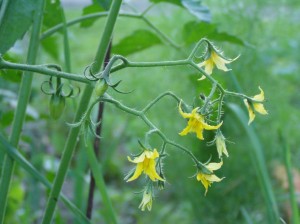 It used to be that seed catalogs came in between Christmas and New Years. Now, they come in between Halloween and Thanksgiving, but that gives us more time to drool over the pictures, I guess.
It used to be that seed catalogs came in between Christmas and New Years. Now, they come in between Halloween and Thanksgiving, but that gives us more time to drool over the pictures, I guess.
This planning season (the winter, versus the planting season, which comes later), Aunt Toby and the DH are taking a really strategic position with regard to the garden. After experiencing “The Summer Without Tomatoes” (I think this has been trademarked), we decided that it was worth going to the experts to try to find a couple of varieties of tomatoes which would be resistant to blight. Now, I will give a certain amount of emphasis to the fact that summer 2009 was about as perfect a period for this disease as you could possibly find: not terribly warm and nice and wet. That stuff took off like wildfire. And seeing how I now have a small but growing pile of seed catalogs on the floor next to the bed (the night stand having been taken over by books long ago), it’s time to start looking.
But before doing that, I want to winnow down the selections because it is so easy to be seduced by the romance novelizations that the copy writers spin in the seed catalogs. I used to be charmed by the descriptions of cashmere sweaters in the Lands End catalogs, but nothing can beat the copy that comes from the word processors of seed catalog writers.
In our area (Upstate New York), our experts come from Cornell University, which is our land grant college. Every state has a land grant college. For a list, go Land Grant Colleges
Cornell University is a treasure chest of information and help and I recently found a site that just deals with plant diseases. Cornell Plant Disease Site
On the site, they have a whole search function by vegetable and on the tomato page, there is a, lucky me, a whole section on late blight. Late Blight
On the left hand side, you can search for ‘Disease Resistant Varieties” – and pick by crop again. The page on tomatoes scrolls down for days. Disease Resistant Tomatoes
I’m going to make the assumption that your land grant college or university has this sort of information tailored to your particular state and so you’ll be able to find what varieties are not only resistant but also those which will work well for you where you garden.
From there, you can pick your varieties and search through the catalogs (or go to the companies’ sites and search by variety there, which I think would be easier and faster).
One of the ‘culprits’ in the tomato blight saga of 2009 was the issue of home and garden centers basically all buying their garden plants from big central growers. In this case researchers were able to locate the grower, in Alabama, which had supplied everyone from Home Depot to Lowes. Buying your own seed, starting mix and growing your own is another way to limit the infectious possibilities.
And, the catalogs next to the bed?
Seed Savers Exchange
Vermont Bean Seed
Totally Tomatoes
Pine Tree Garden Seeds
Until the next time.

While not a catalog, here’s a link to a heirloom seed collector that is the only commercial source for the Canadian Crookneck Squash. Now you wonder Aunt Toby how did Millineryman came across this? Well he found it in SlowFoods USA Ark of Tatse, another catalog, this time of rare and threatened foods of the USA. Too bad Jello ain’t on that list.
http://www.heritageharvestseed.com/
http://www.slowfoodusa.org/index.php/programs/details/ark_of_taste/
Oh, how I love seed catalogue time! Aside from gardening itself, it is my favorite time of the year. This year I’m dealing with Stokes for most of my seeds, mainly carrots-in 3 varieties-beets and green beans. Turnout the Kid loved green beans, so we’ll grown them next year and can some after we eat our fill. The toughest part is waiting ’til spring…